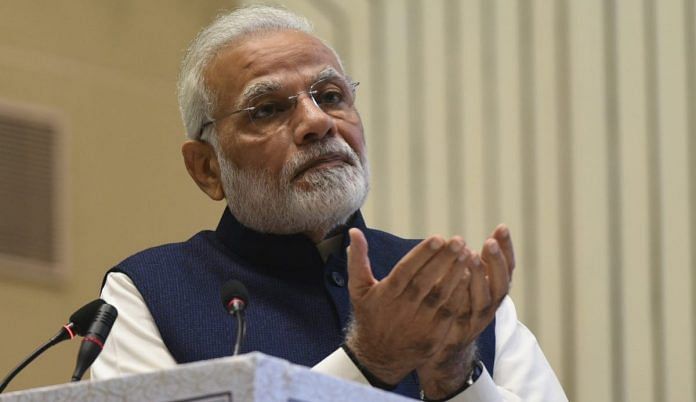Government data shows 12 of the 26 cabinet ministers in the Modi administration are yet to adopt a village under the third phase of the scheme.
New Delhi: Prime Minister Narendra Modi’s signature initiative — the Saansad Adarsh Gram Yojana (SAGY) — has not been such a big hit with his own cabinet colleagues. Nearly half of them are yet to adopt a gram panchayat under the third phase of the programme.
Data available with the rural development ministry (as on 26 June), which oversees the implementation of the scheme, shows 12 of the 26 cabinet ministers and four of the 11 ministers with independent charge are yet to adopt a gram panchayat under the third phase.
Modi adopted his third gram panchayat in July 2017.
Officials in the ministry say there is still a year to go for the end of this government’s tenure and MPs are free to adopt a gram panchayat even now. However, the timeline states that each MP must develop three gram panchayat by 2019. Given the fact that the process requires time, it seems unlikely that adopting a gram panchayat now will yield any concrete results.
What the data says
Officials in the ministry, however, say the data is still being updated by districts so these numbers may not reflect the latest picture.
In the available list of MPs who have adopted gram panchayats in Phase III, some names have been added as recently as on 23 June. Even with a lag, the data clearly shows several MPs, including the 12 cabinet ministers, hadn’t moved to adopt a gram panchayat in the third phase until recently.
The list of cabinet ministers who haven’t yet adopted a gram panchayat in the third phase includes road transport minister Nitin Gadkari, oil minister Dharmendra Pradhan, law minister Ravi Shankar Prasad, textiles minister Smriti Irani, steel minister Birender Singh, social justice minister Thaawar Chand Gehlot, human resource development minister Prakash Javadekar, commerce minister Suresh Prabhu, statistics minister D.V. Sadananda Gowda, parliamentary affairs minister Ananth Kumar, heavy industries minister Anant Geete and Arun Jaitley.
Of these, names of Gadkari, Prasad, Kumar and Geete also do not appear in the list of those who adopted gram panchayats in the second phase.
Lok Sabha Speaker Sumitra Mahajan too has not picked a gram panchayat in the third phase.
The four ministers with independent charge absent from the third-phase list are AYUSH minister Shripad Naik, DONER minister Jitendra Singh, MSME minister Giriraj Singh and tourism minister K.J. Alphons.
Jitendra Singh said he has identified villages under the third phase but the ministry records are yet to be updated.
“I have identified villages under Phase II and III as well, and the same was communicated to the concerned ministry. I have, in fact, adopted five villages in the second and third phases. Overall, I have notified eight villages. The ministry records, unfortunately, are not updated. The work in villages adopted under the third phase hasn’t started yet, and we won’t be able to complete it by 2019. But villages have been notified and the ministry intimated,” Jitendra Singh said.
Alphons told ThePrint that he has adopted only one village so far because he became an MP only in November 2017.
“I have adopted only one village: Vassi Khas in Dungarpur District of Rajasthan. I propose to add one more this year,” he said.
ThePrint has also reached out to all other ministers who have not adopted villages through emails and text messages. The report will be updated as the responses are received.
The third phase numbers compare to 500 Lok Sabha and 203 Rajya Sabha MPs who adopted gram panchayats in Phase I, and 350 Lok Sabha and 128 Rajya Sabha MPs in Phase II of the programme.
How the scheme works
Under SAGY, MPs have to adopt a gram panchayat in their constituencies for all-round development using existing resources and rural schemes as well as MPLAD funds. Rajya Sabha MPs can select a gram panchayat in any district of the state from which they have been elected.
Each MP is free to identify any gram panchayat to be developed as a ‘model village’, except his or her own gram panchayat and that of his/her spouse. As per the target, every MP will develop one gram panchayat by 2016 and two more by 2019.
The scheme has seen personal investment from PM Modi, who announced it in his first Independence Day speech in 2014 and launched it later that year amid much fanfare.
Structural issues
MPs have earlier emphasised that the scheme has largely failed because of structural issues as well as poor planning and design.
The scheme has no funds allotted to it separately and MPs are merely expected to use their MPLAD funds as well as ensure more effective utilisation of funds for existing rural schemes. This, MPs complained, resulted in the inability to show concrete results.
The legislators also believed adopting just three gram panchayats in their entire constituency put them in a spot, making it difficult for them to explain to the others why they weren’t picked. Some MPs also blamed the lack of cooperation by state and district administration in the initial phases of the scheme for their reluctance to pick more gram panchayats.




Something is better than nothing
A good scheme for which apathy shown by MPs is not good. Any way even 30% have done it, it will be helpful